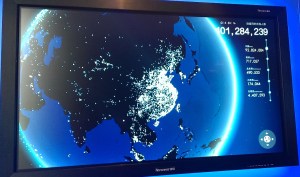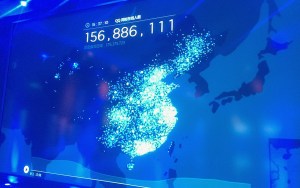Tencent?s?social blogging site, Qzone, has Asia?s largest active social network user base, with 600 million (and counting) users who log in more than twice a month.
Besides Qzone, the Chinese Internet giant is perhaps better known for its flagship QQ instant messenger and the exploding WeChat smartphone messaging app.
I spoke to Peter Zheng, vice president of Tencent?s social network group. He?s been overseeing Qzone?s evolution for the past eight years. He told me that when Qzone?was launched in 2005, it was initially planned as a Geocities-style blog community, before the company decided to add social aspects by linking blogs to users? QQ accounts. ?Luckily, when we started, Facebook wasn?t common in China. There were some challenges from other platforms like microblogs such as Weibo, but these [Twitter-like channels] are quite public, and people saw QZone as a more private space,? he said.
It wasn?t always supposed to be walled, but QZone inherited the company?s older QQ contact list that added people based on user IDs, not more universal identifiers like email addresses or phone numbers. And unlike what we?re used to on Facebook or LinkedIn for example, you can?t see who your friends? friends are because of the way those lists were architected, said Zheng.
?For a while, we were concerned that that made it hard for people to expand their friends lists. Our legacy was closed, and we thought it hindered the expansion of the network,? he said. But it seemed to work out. ?Over time, our users told us that they didn?t want to add contacts the way you do on Facebook. When everyone is added?deliberately?because you sought them out, you?re just adding buddies you want to share your updates with. Turns out that was a way to keep your friend circles tight, and our users are keener to share on Qzone because of that,? he said.
This is the mantra of some of the ?private? sharing platforms like?Path?some with more success than others?but Tencent seems to have stumbled upon the working formula and had its popularity multiplied by the sheer volume of users coming onboard in its home country.

Over 100 million users concurrently on Qzone, with most of them concentrated in China
Another way it has fueled its user growth is an early emphasis on the mobile phone. The Qzone app was released in early 2010,?and included features like photo filters and the option to record voice memos. While a typical Twitter or Tumblr user would take a photo, open it in a separate app to dress it up, then open the blogging app to post it, all of this can be done within Qzone?s app, reducing the friction to post. (Instagram was launched towards Fall 2010.)
The Qzone app has also added features that caught on with Asian users earlier than they did in the West, such as decorative water marks. ?Asian users like to decorate their photos, not just filter them,? he said. Qzone?s app also allows users to add a voice clip as a status update, or tag it to a photo. ?That makes it feel more personal. You can send a gift and attach a voice clip from the phone too,? Zheng said.
When he showed me a typical Qzone page, I was boggled by how busy the page was, with animations and audio. ?It?s almost like MySpace,? I say.
?Sort of,? he agreed. ?But it isn?t really the form factor that matters the most. Maintaining the relationship with your existing user base and keeping them happy goes a long way. You want to be on the social network that your friends are on, and always keeping it fresh means users stay happy.?
Tapping the ideas of 22,000

It is here in Shenzhen?s hi-tech district that Zheng?s 2,000 or so engineers work on Qzone.?The Tencent headquarters is a sprawling skyscraper, dwarfing its myriad grey-washed neighbors. While I had problems getting my cab driver to register exactly where I wanted to be in the already famous Hua Qiang Bei cluster, simply saying ?Tencent? in English got him to immediately acknowledge, exclaiming ?Teng Xun Da Sha?, which translates to Tencent Plaza in Mandarin.
Started in 1998, Tencent is China?s largest Internet company by revenue, and was the first Internet company in the country to break through the $1 billion revenue mark in 2009.
My arrival at the headquarters was kicked off with a tour of the impressive lobby showcase area. A big, gleaming board reflected how many users were concurrently on QQ?156 million that Wednesday afternoon, with a peak of 172 million. The company counts an active user as someone who logs in more than twice a month, and by that measure, has an impressively high retention rate of 700 million out of its 1 billion total users worldwide.

156 million users chatting on QQ instant messenger at the same time
?This is the same tour that our CEO, Pony Ma, gave to (Chinese Communist Party general secretary) Xi Jinping when he visited,? informed my guide in impeccable English. I asked her how long she?s been working for Tencent, and she said she?s been with the company for the past two years since she graduated. ?I do not consider myself young here,? she said, shaking her head.
And perhaps she can?t. The average age of Tencent?s 22,000 employees is merely 26?a feat made possible by an aggressive, ongoing hiring campaign that takes Tencent to tertiary institutions in the country in order to sniff out their finest.
The constant influx of fresh blood could be one of the reasons why Tencent has kept up with China?s relatively young Internet population. China?s average age across its user base is just 25, while in the US, that number is much higher at 42.
How do you juggle ideas coming in from thousands of young, enthusiastic minds? ?Unfortunately, you have to cancel projects if they don?t work after a certain time, usually several weeks or months,? said Zheng.
?There are no bad ideas, only bad execution. So we give all ideas a fair chance, but we look for teams with bad execution and we do kill their projects,? he said.
Per the company?s claims as of March 2008, Tencent is China?s largest and most utilized internet services portal. The company powers popular products like instant messaging and gaming service QQ and e-commerce and online trading platform PaiPai, amongst others.
? Learn moreQQ.com is TenCent?s main brand, providing a litany of services through its portal. Most widely known for its instant messaging service, QQ also features anti-virus solutions, email, download management, premium services, live video streaming, online dating, and mobile solutions.
? Learn moreMuch like South Korea-based Cyworld, QZone is a virtual world and social networking application for self-expression and content sharing.
? Learn moreSource: http://techcrunch.com/2013/04/18/how-tencents-walled-user-list-ended-up-boosting-its-userbase/
Lone Star College 42 louisville basketball Ready for Love ncaa annette funicello margaret thatcher
No comments:
Post a Comment
Note: Only a member of this blog may post a comment.